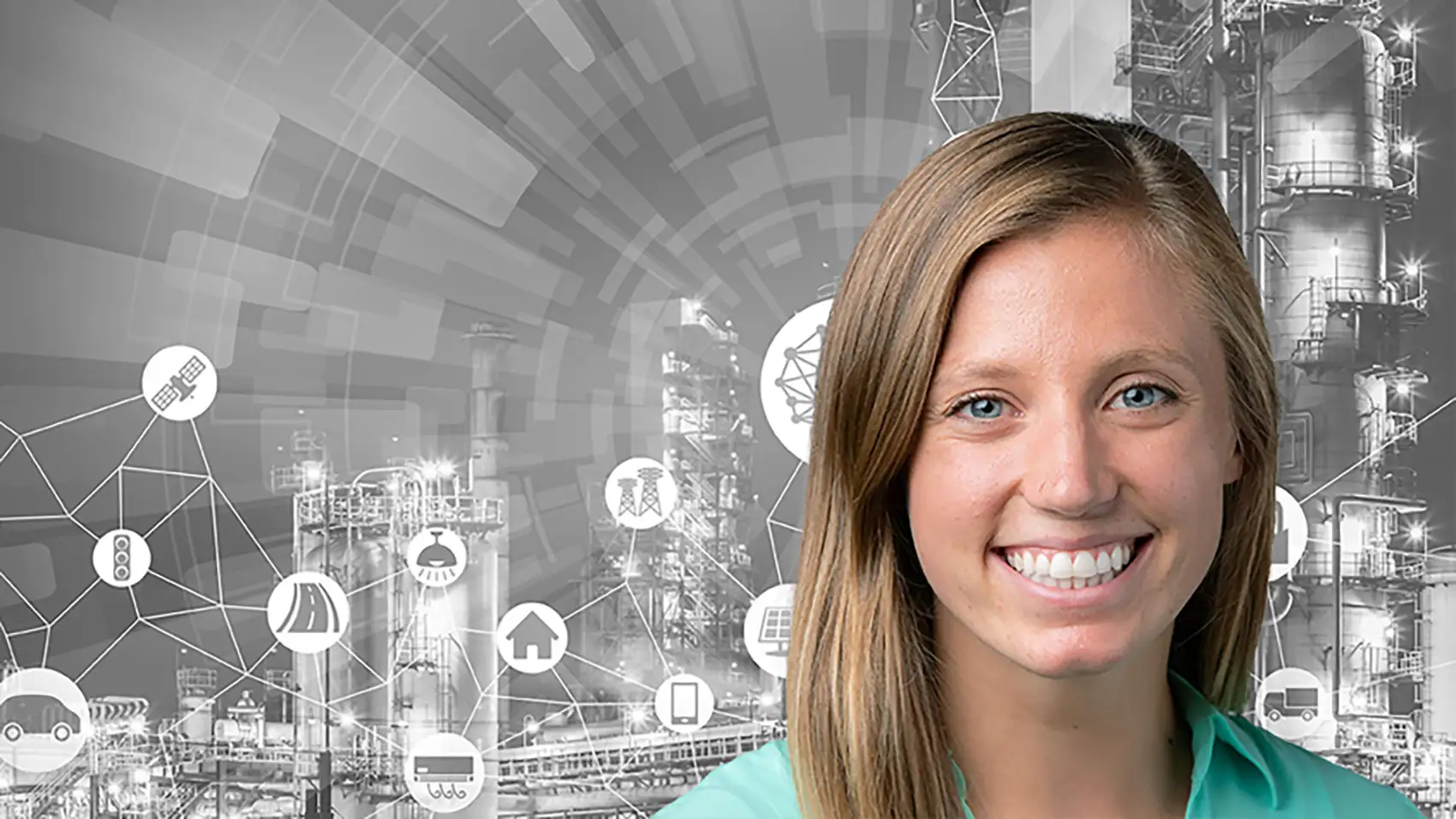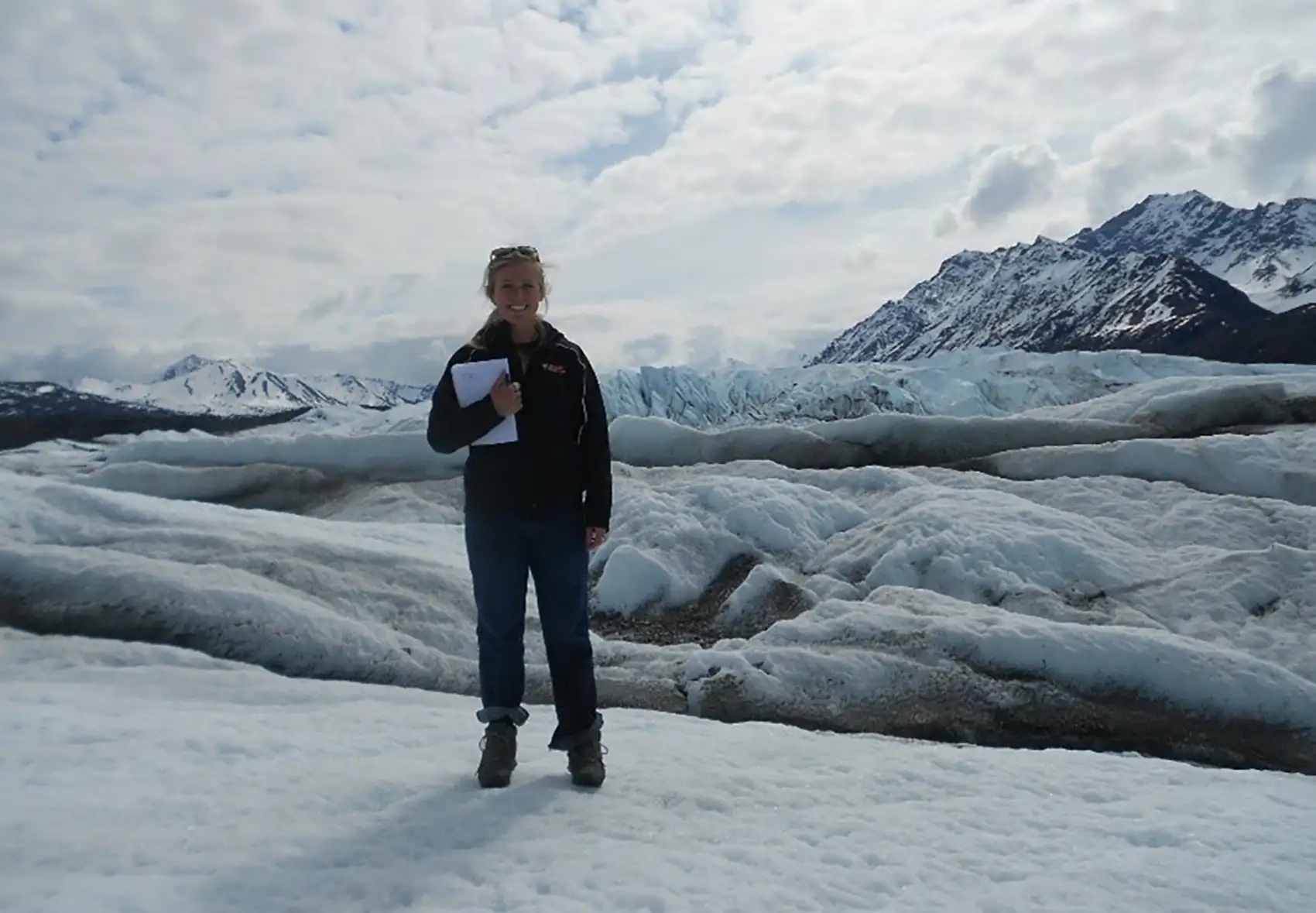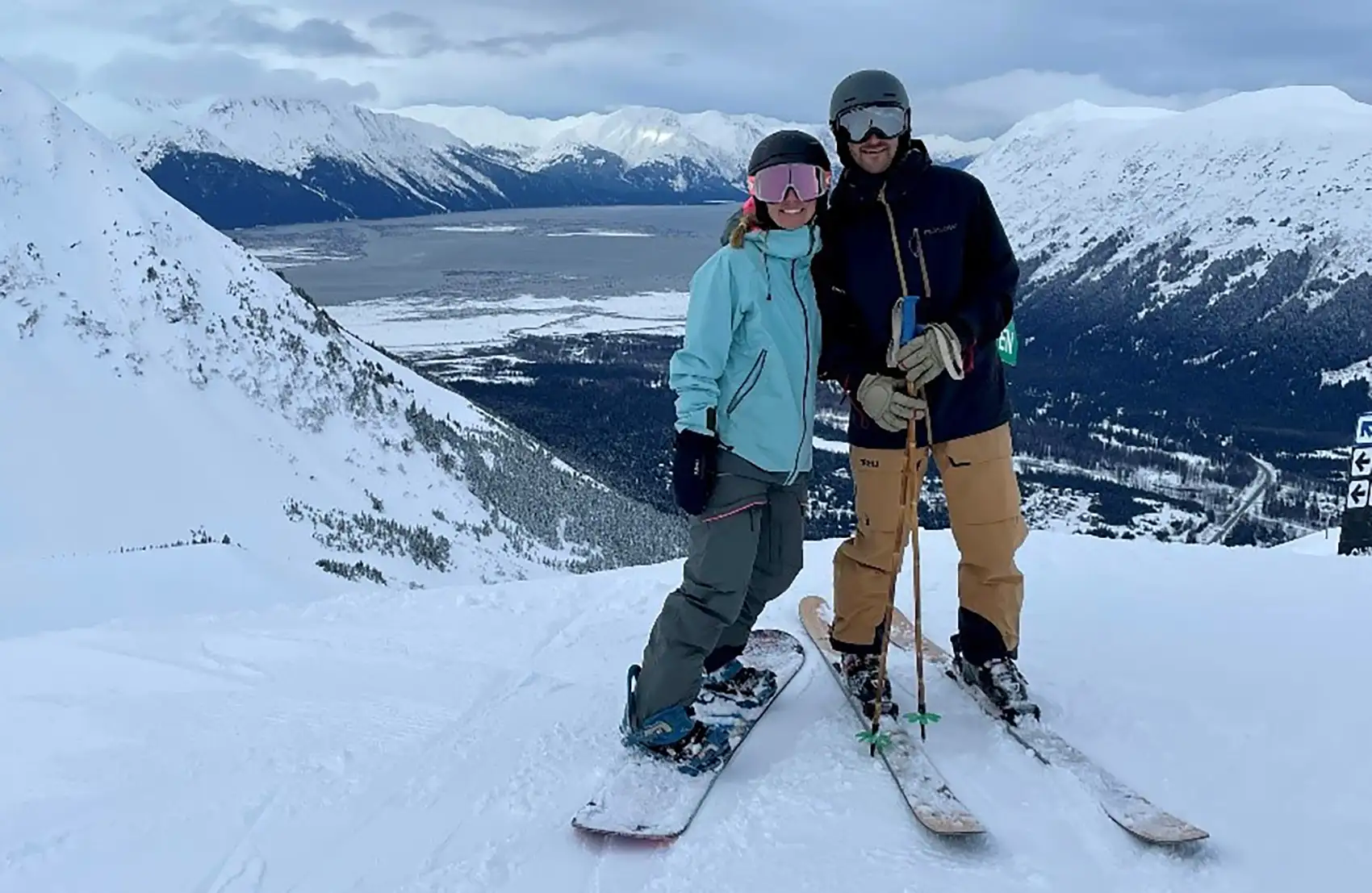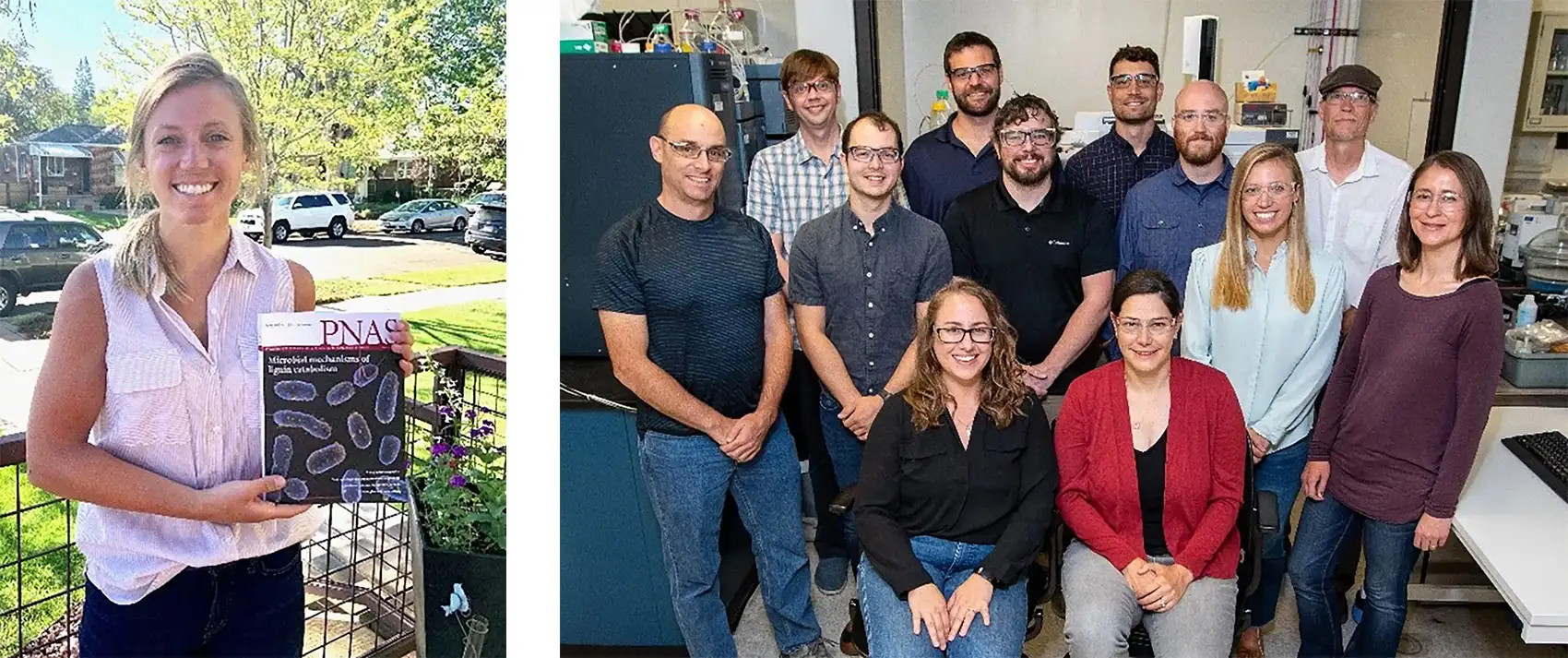Q&A With Alli Werner: Engineer Enlists Tiniest Engineers (Microbes) To Recycle Plastics, Mine for Metals, and More

Before she could walk, Alli Werner was composting and sorting recyclables.
“My father was ‘reduce, reuse, recycle’ before it was cool,” said Werner, a biological engineer at NREL.
Werner grew up in rural Michigan among its soggy mosses and boggy wetlands. But it was not necessarily her natural environment that steered her career but rather her familial one. Her dad, who spent his entire career with Michigan’s Department of Environmental Quality, could (and would) tell his daughter the scientific name for every plant, bird, or animal in Michigan. Then, he would explain why even a common, humdrum plant, like the Taraxacum officinale, is like a vital organ in an ecosystem’s body.
“As a kid, you’re like, ‘Dad, just call it a dandelion,’” Werner said. “Now you look back and you're like, ‘Wow, that was really impressive and cool.’”
Werner’s mother, a pharmacist, also influenced her career choices, providing a glimpse into another side of science. And she, too, ascribed to reduce, reuse, recycle: Raised on a Michigan farm, her mom was “a straight-up farmer girl,” Werner said. The first real recyclers and reusers were, like farmers, “born out of frugality,” she added. Early farmers often composted, turning food waste into fertilizer, and repurposed or repaired their busted tools.
But even if farmers were some of the first real recyclers, they are far from the first.
Today, Werner works directly with some of the planet’s most ancient and capable recyclers: microbes. She engineers these microscopic machines to transform plastic waste into sellable goods, mine for metals in electronic waste, and break down lignin—a gritty, tough type of polymer found in plant stalks—so it can be repurposed to make textiles and fuels.
“I’m generally a curious person,” Werner said. “I like asking questions to try to understand the microscopic world better. But my motivation is really about building things to make the world a better place. And it felt like biological engineering was where I could merge those two things.”
In the latest Manufacturing Masterminds Q&A, Werner shares why she thinks high school students should not have to choose between sports and science, what a summer internship at an Alaskan glacier taught her about field work, and how her latest breakthroughs could help make it easier, cheaper, and less toxic to recover precious metals—some of which cannot be found naturally in the United States. This interview has been edited for clarity and length.

What’s your origin story? When did you know you wanted to make the world a better place?
I don’t think I can point to a single moment. But my father instilled that we have a responsibility to be stewards for the Earth, and that got me thinking about environmental reciprocity from an early age. In high school, I struggled between my identity as an athlete and as a scientist or nerd. In the community that I grew up in, those were two different things that you had to choose between.
Which sports were you into?
Team sports, especially soccer. But I also really wanted to pursue engineering. I had some teammates go on to play Division I sports, and they had to drop their major almost immediately because the coursework didn’t align with their sports schedule. I remember that being really influential for me in terms of deciding which path I wanted to pursue. Though, I think it’s totally possible and in fact really beautiful when you can do both.
Obviously, you chose engineering. Any regrets?
No, not at all. I think there’s some element of, “How good could I have been?” But to be honest, I was not recruited by very many Division I schools. I was not going to be an Olympian. But I think the fact that it’s presented as a decision to young kids is problematic. I think about one day hosting a summer camp for kids to do science and sports to show them that you can do both. And I actually did do both. I played soccer all through college, it was just Division III so it wasn’t as demanding.
Do you still play soccer?
Well, I haven’t since I had my first kid a year and a half ago, but I played soccer all the way up until then.
Apart from the engineering or sports conundrum, did you face any other career obstacles?
The same that I think everyone faces, which is trying to do your best in a world you don’t always feel equipped to face. As a student in engineering school, most classes were one woman to 5–10 men, but I didn't feel that was an obstacle. I just felt like, ‘Well, I’m interested in it, so I'm going to enroll.’ Honestly, these days, being a mother is when I’ve felt the rubber has hit the road. The higher in an organization or the more senior the leadership position, the fewer women you see. Luckily, I have an incredibly supportive husband and team at NREL who let me try to find balance between home and work life.
You knew you’d go into biological engineering, but how did you choose your specialty?
The fantastic internships I had as an undergrad. I was awarded a Research Experiences for Undergraduates award from the National Science Foundation where they place students across the country and handle all of the logistics. For example, for my first internship, I went to Alaska. That was an extremely intimidating thing to do. But these programs make it really accessible.

What did you do in Alaska?
I worked with Dr. Fred Rainey going out to the Matanuska Glacier. We collected water samples and isolated radiation-resistant bacteria and characterized them. The goal was to understand how they were so radiation tolerant and how life on Mars might exist.
Did you have other internships, too?
Yes. During the school year, I drove out to the Medical College of Wisconsin to help study brain cancer. That was of course very human-health oriented, which is another prominent application for biological engineering. I got to work with real patient samples trying to understand biomarkers for glioblastomas.
And then, in another internship at Colorado State University, I was trying to engineer cyanobacteria to make biofuels from sunlight. And it was there that I met my future Ph.D. advisor. We got along really well. I really liked her research. And when I applied to the school and was admitted, I was able to join her lab immediately instead of having to do the standard rotation. It felt like a fast track to get my hands dirty in the lab.
How did you get from Colorado State to NREL?
For personal reasons, I wanted to stay in Colorado. One of my committee members knew Gregg Beckham, a chemical engineer at NREL, and thought I’d like his research. All my other prospects were in the San Francisco Bay Area, and I wasn’t enthused about moving. And once I met Gregg and talked to his team, I became super excited about the research and NREL.
What happened after you came to NREL? Has your role changed?
My role has changed over the years, but my core mission remains. When I joined, I was a postdoc. For the first probably four years I was here, every day was grinding in the lab. For a biological engineer, that’s doing a lot of pipetting clear liquid into clear liquid, basically using molecular scissors to copy and paste DNA. It’s not a glamorous thing to see.
What were you doing with those clear liquids?
Engineering microbes to convert the carbon from waste into carbon that has some value. For example, all sorts of plants use a biopolymer called lignin for strength, and there’s a lot of it on Earth that's wasted. So, we develop strategies to reuse that carbon to make new textiles or fuels that would perform better in your clothing or jet engine. A few years in, I got involved in applying the same type of approach and tool set but to plastics.
Like, using microbes to recycle plastic waste?
Yeah. So, we take waste plastics, use chemistry to break it down into usable intermediates, and then engineer the microbe to turn those intermediates into a product that you could sell—the idea of upcycling is to make recycling more profitable by creating a high-value product.
What kinds of products can you make?
That’s the really cool part about being a biological engineer—we can make all sorts of things! You can think of metabolism like a highway map where each road is an enzyme-catalyzed reaction. And then the houses or the destinations are different products. We often make an adipic acid because it has a big market as a commodity chemical. It’s used to make things like nylon, which is in my shirt and stretchy jeans, but also automotive parts and all sorts of really important industrial products. We can also make polymers, like polyhydroxyalkanoates, used in compostable cups or other applications where biodegradation is an important feature.
What else can these magical microbes do?
People don't know this—I actually didn’t know this until several years ago—but around 20% of copper and 5% of gold is mined using microbes today. It’s a big industrial process. People call it biomining. There’s a lot of electronic waste—your phone, your laptop—that contain metals that were really energy intensive to extract—and metals we don’t have much of in the ground in the United States. We have a lot of incentive to reclaim these instead of just dumping them in a landfill or shipping them to another country because we don’t know what to do with them. Microbes can extract metals from different types of minerals. So, we’re trying to adapt our work on waste feedstocks for metal waste.
Wow. So, literally microbes mining metals from electronic waste. How cool.
The other challenge with metals is separations. Let's say you’ve gotten all the metals from your old phone into some liquid where they’re soluble. How do you pull each apart? It turns out life—you and I but also my microbes—requires metals to live. Every cell uses around 10 or more metals just to survive. These biological systems have developed elegant ways of sorting and recognizing specific metals to keep them all straight, often with metal-binding proteins. We're trying to use those proteins to sort different types of metals and separate them into pure streams that have value.
So, what’s next? Is there an upcoming project that you’re especially excited about?
Picking is so hard! There are 20 things I could say. Can I pick one thing from lignin, plastics, and metals?
Sure, go for it.
On the lignin side, our biggest breakthrough was developing a chemistry that could break down more of the lignin, and then a strain that can process all the breakdown products—essentially, we’ve doubled the amount of final product we can get from lignin.
Wow. That’s huge. And on the plastics side?
We’ve made some recent breakthroughs in recycling polyethylene, the most commonly produced plastic. We’ve developed some cool new biological insight into how our microbe is eating those products, and we’re at the cusp of developing new products we could shuttle that carbon into.
And in metal mining?
We’re trying to understand how and where rare earth elements are being trafficked around cells. About 15 years ago, it was discovered that an enzyme requires rare earth elements. Since then, the field started asking “Why? How does the metal get inside the cell? Where does the metal go after it’s imported?” You might be tempted to say those are inconsequential questions to an engineer trying to recycle metals from waste. But there are a lot of gifts to be gained from understanding why things work or don’t work, and there are practical things you can learn by allowing yourself to understand some of the miraculousness behind biology.
My sister is an artist, and she stylized a quote that sits on my desk. It says, “Beautiful questions elicit answers in their likeness.” It’s a reminder to me to stay curious, not sell biology short, and ask beautiful questions.
Any examples of these beautiful questions?
Only in the last 10 to 20 years has the scientific community understood that a handful of microbes use rare earth elements. So, OK, how widespread is this in the soil? What about the ocean? I think we’re at the cusp of breakthroughs in our understanding of the role rare earth elements play in life in general. In our work, we’re discovering new classes of proteins that bind rare earth elements from one particular soil microbe, that we can ultimately leverage to develop better biotechnology.

Because this is the Manufacturing Mastermind series, I have to ask, how does your work integrate with manufacturing?
To manufacture rare earth elements, separations is really challenging. Today, that often looks like a warehouse where, as far as you can see, there are giant metal tanks full of solvent that gradually separate the metals. This requires a huge amount of chemical inputs, expensive equipment, and ultimately results in staggering emissions to produce things like neodymium that are used in powerful magnets essential to all sorts of energy, electronic, and defense technologies.
The technologies that we’re developing could transform separations to be mainly in water, which could reduce the toxicity, solvent demand, and emissions tremendously. Obviously, we have a lot of work to do to make it cost competitive and scale well. But we have several industrial partners who are showing interest and are forming a lot of really exciting collaborations with fantastic groups across the country. So, we're hopeful that some of our metal separations technology could impact the manufacturing of rare earth elements in the near term.
In an ideal world, what would you most hope to accomplish by the end of your career?
The very first thing that came to mind was to make the world and the environment a better place for my daughter. If anything I do could make the air a little cleaner for her to breathe, the biodiversity a little more expansive by the time she's my age, that would be a success.
What advice would you give to folks who might want to follow in your footsteps?
Don’t be intimidated by people who seem like they know what they're doing because they probably don't. They're probably figuring it out day by day, step by step.
I love that. It took me a while to learn that one.
Yep, we’re all just figuring it out as we go.
Last Updated May 28, 2025
